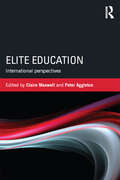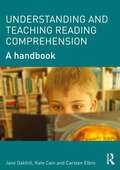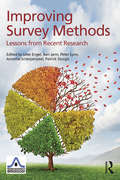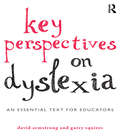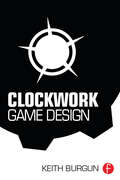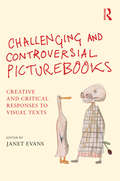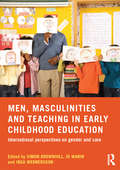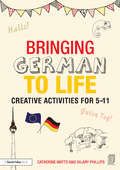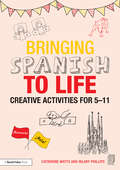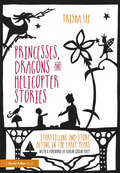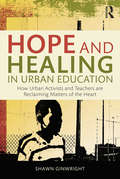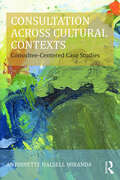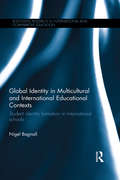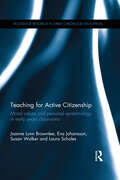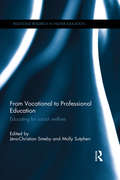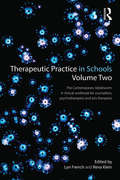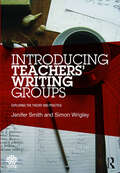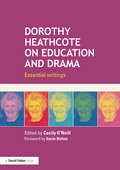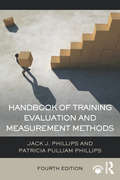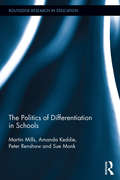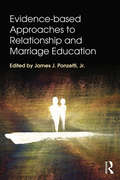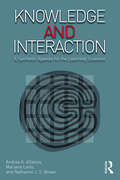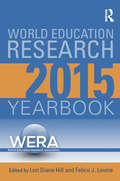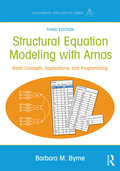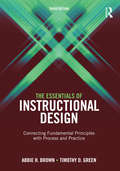- Table View
- List View
Elite Education: International perspectives
by Peter Aggleton Claire MaxwellElite Education – International Perspectives is the first book to systematically examine elite education in different parts of the world. Authors provide a historical analysis of the emergence of national elite education systems and consider how recent policy and economic developments are changing the configuration of elite trajectories and the social groups benefiting from these. Through country-level case studies, this book offers readers an in-depth account of elite education systems in the Anglophone world, in Europe and in the emerging financial centres of Africa, Asia and Latin America. A series of commentaries highlight commonalities and differences between elite education systems, and offer insights into broader theoretical issues, with which educationalists, researchers and policy makers are engaging . With authors including Stephen J. Ball, Donald Broady, Rubén Gaztambide-Fernández, Heinz-Hermann Krüger, Maria Alice Nogueira, Julia Resnik and Agnès van Zanten, the book offers a benchmark perspective on issues frequently glossed over in comparative education, including the processes by which powerful groups retain privilege and ‘elite’ status in rapidly changing societies. Elite Education – International Perspectives will appeal to policy makers and academics in the fields of education and sociology. Simultaneously it will be of special relevance to post-graduates enrolled on courses in the sociology of education, education policy, and education and international development.
Understanding and Teaching Reading Comprehension: A handbook
by Jane Oakhill Kate Cain Carsten ElbroThe ultimate aim of reading is not the process but to understand what we read and comprehension can take place at many different levels. There has been an increasing emphasis on the importance of reading comprehension in recent years but despite this there is very little written on this vital topic accessible to trainee and practicing teachers. The Handbook of Reading Comprehension presents an overview of recent findings on reading comprehension and comprehension problems in children. It provides a detailed examination of the characteristics of children who have reading comprehension difficulties, and examines ways in which comprehension can be supported and improved. It is accessibly written for students and professionals with no previous background in the psychology of reading or reading problems. This indispensable handbook asks the question ‘what is comprehension?’ The authors consider comprehension of different units of language: understanding single words, sentences, and connected prose and outline what readers (and listeners) have to do to successfully understand an extended text. This book also considers comprehension for different purposes, in particular reading for pleasure and reading to learn and explores how reader characteristics such as interest and motivation can influence the comprehension process. Different skills contribute to successful reading comprehension. These include word reading ability, vocabulary knowledge, syntactic skills, memory, and discourse level skills such as the ability to make inferences, knowledge about text structure, and metacognitive skills. The authors discuss how each one contributes to the development of reading comprehension skill and how the development of these skills (or their precursors) in pre-readers, provides the foundation for reading comprehension development. Areas covered include:- Word reading and comprehension Development of comprehension skills Comprehension difficulties Assessment Teaching for improvement Throughout the text successful experimental and classroom based interventions will be highlighted, practical tips for teachers and summary boxes detailing key points and explaining technical terms will be included in each chapter
Improving Survey Methods: Lessons from Recent Research (European Association of Methodology Series)
by Uwe Engel Ben Jann Peter Lynn Annette Scherpenzeel Patrick SturgisThis state-of-the-art volume provides insight into the recent developments in survey research. It covers topics like: survey modes and response effects, bio indicators and paradata, interviewer and survey error, mixed-mode panels, sensitive questions, conducting web surveys and access panels, coping with non-response, and handling missing data. The authors are leading scientists in the field, and discuss the latest methods and challenges with respect to these topics. Each of the book’s eight parts starts with a brief chapter that provides an historical context along with an overview of today’s most critical survey methods. Chapters in the sections focus on research applications in practice and discuss results from field studies. As such, the book will help researchers design surveys according to today’s best practices. The book’s website www.survey-methodology.de provides additional information, statistical analyses, tables and figures. An indispensable reference for practicing researchers and methodologists or any professional who uses surveys in their work, this book also serves as a supplement for graduate or upper level-undergraduate courses on survey methods taught in psychology, sociology, education, economics, and business. Although the book focuses on European findings, all of the research is discussed with reference to the entire survey-methodology area, including the US. As such, the insights in this book will apply to surveys conducted around the world.
Key Perspectives on Dyslexia: An essential text for educators
by David Armstrong Garry SquiresThis indispensable book critically sets out the skills and knowledge required by a specialist educator for students who present with dyslexia. The British Dyslexia Association Professional Criteria (BDA, 2012) provides an anchor throughout for this book’s content. Chapters are explicitly mapped to specific professional criteria, offering the reader confidence that guidance in Key Perspectives on Dyslexia is underpinned by this internationally recognised professional framework.?? Key issues in the education and care of those affected by dyslexia are critically explained and explored in this publication, using both author’s years of specialist experience in this field. As established scholars both authors also suggest how research can inform and enrich how an educator responds to these issues.?? The content of this book includes: Detailed case studies disclosing how dyslexia presents in different individuals and which richly illuminate the issues considered by each chapter A concise examination of reading instruction in the context of typically-developing students and in relation to those who present with dyslexia: this incorporates an expert but accessible review of international policy and educational practice, including influential findings from research Detailed guidance on how to identify possible dyslexia and key issues to consider in referral and assessment of those affected, including associated models here such as Response to Intervention (RTI)? Consideration of intelligence and in how this figures in relation to assessment for dyslexia, including the possible role of intellectual disability (ID). Comprehensive evaluation of the role of behaviour in relation to dyslexia, with guidance on how this can be used to inform a programme of support for students with social, emotional or behavioural difficulties (EBD/SEBD). Consideration of how the professional role of a specialist educator might travel across the English speaking world and also beyond in China or India.?? Key Perspectives on Dyslexia is an essential text for educators and will become a landmark guide for educational practice and policy.???
Clockwork Game Design
by Keith BurgunOnly by finding and focusing on a core mechanism can you further your pursuit of elegance in strategy game design.Clockwork Game Design is the most functional and directly applicable theory for game design. It details the clockwork game design pattern, which focuses on building around fundamental functionality. You can then use this understanding to prescribe a system for building and refining your rulesets. A game can achieve clarity of purpose by starting with a strong core, then removing elements that conflict with that core while adding elements that support it.Filled with examples and exercises detailing how to put the clockwork game design pattern into use, this book is a must-have manual for designing games. A hands-on, practical book that outlines a very specific approach to designing games Develop the mechanics that make your game great, and limit or remove factors that disrupt the core concept Practice designing games through the featured exercises and illustrations
Challenging and Controversial Picturebooks: Creative and critical responses to visual texts
by Janet EvansIt is often assumed that picturebooks are for very young readers because of their emphasis on the illustrations and their scarcity of text; however, there are increasing numbers of picturebooks where the age of the implied reader is questionable. These are picturebooks whose controversial subject matter and unconventional, often unsettling style of illustration challenge the reader, pushing them to question and probe deeper to understand what the book is about. In addition to the book challenging the reader, the reader often challenges the book in an attempt to understand what is being said. These increasingly popular picturebooks work on many different levels; they are truly polysemic and worthy of in-depth analysis. They push the reader to ask questions and in many instances are intrinsically philosophical, often dealing with fundamental life issues. Challenging and Controversial Picturebooks examines these unconventional, non-conformist picturebooks, considering what they are, their audience and their purpose. It also considers: Children’s and adults’ thoughts on these kinds of picturebooks. How challenging and unsettling wordless picturebooks can play with the mind and promote philosophical thought. What creates non-conformity and strangeness … is it the illustrations and their style, the subject matter or a combination of both? Why certain countries create, promote and accept these picturebooks more than others. Why certain picturebooks are censored and what factors are in play when these decisions are made. The role of publishers in translating and publishing these picturebooks. Children’s creative and critical responses to strange, unsettling and often disturbing visual texts. This inspiring and thought-provoking volume explores the work of a number of highly respected, international picturebook experts and includes an exclusive interview with the legendary Klaus Flugge, Managing Director of Andersen Press, one of the few remaining independent children’s book publishers in England. It is an indispensable reference for all interested in or working with picturebooks, including researchers, students in higher and teacher education, English advisors/inspectors, literacy consultants and classroom teachers.
Men, Masculinities and Teaching in Early Childhood Education: International perspectives on gender and care
by Simon Brownhill Jo Warin Inga WernerssonThis stimulating book sets out to critically explore the notion of men, masculinities and teaching in early childhood education. It addresses the global pattern of gender, teaching and care where men are in the minority, and explores the notion that the greater involvement of men within teaching and associated professions has the potential to transform gender relations for future generations. International contributors raise critical questions about the construction of masculinities, the continuing reluctance of men to engage in this type of work, and the influence of political and public debates on the issue. Through this engaging discussion readers are asked to question whether this is something that we should care about, with key topics including: The roles of men in education and care Teachers’ beliefs, norms and values of gender equality The construction of male identities Gendered ideals, and children’s interpretations of gender. Men, Masculinities and Teaching in Early Childhood Education brings together a refreshing and critical set of perspectives linked to an increasingly important educational debate and will be a valuable text for practitioners, professionals, policy makers and parents/carers.
Bringing German to Life: Creative activities for 5-11
by Catherine Watts Hilary PhillipsBringing German to Life provides an innovative and refreshing cross-curricular approach to teaching languages in primary schools, combining art, design and foreign languages with various aspects of the National Primary Curriculum such as Literacy, Numeracy and PE. This unique practical resource comprises an engaging storyline about a day in the life of two German children and gives an opportunity for learners to re-enact their day, using finger puppets, handmade crafts and exciting games to practise new language. Each of the 14 sections begins with a short accessible dialogue in German and is followed by suggestions for using the new vocabulary in pairs, small groups or as a whole class. The main story is accompanied by fun craft activities linked to the story (one for each section, ie 14 in total) for children to create in class using the templates and instructions provided. A wide range of further activities follows, consisting of lively games, songs and opportunities to communicate simple ideas. Language extensions are suggested, focussing on imaginative writing and reading ideas linked to the theme of each section. Written to support the new foreign languages programme of study, the book also includes: * Cross-curricular links to numerous subjects including Literacy, Numeracy, PE and ICT * Classroom games and activities * Photocopiable resources and templates for fun classroom activities and projects * Language extension activities. Bringing German to Life can be read on three levels to suit a variety of classroom situations. First, the story can be told ‘straight’ with the whole class participating in the dialogues. Second, the story can be combined with the craft activities after each main section. 14 doing and making activities match the storyline and provide a colourful, eye-catching display and learning focus in the classroom or for Open Days or Assemblies. Teachers can use as many or as few as they wish. The resultant crafts can be used for very effective classroom displays/open days/assemblies etc. Finally, the language extension activities can be used alongside the art/craft/design activities as desired. The aim of these activities is to extend the target language in a relevant context through a variety of methods such as songs, playlets, simple communicative exchanges, games with numbers etc.
Bringing Spanish to Life: Creative activities for 5-11
by Catherine Watts Hilary PhillipsBringing Spanish to Life provides an innovative and refreshing cross-curricular approach to teaching languages in primary schools, combining art, design and foreign languages with various aspects of the National Primary Curriculum such as Literacy, Numeracy and PE. This unique practical resource comprises an engaging storyline about a day in the life of two Spanish children and gives an opportunity for learners to re-enact their day, using finger puppets, handmade crafts and exciting games to practise new language. Each of the 14 sections begins with a short accessible dialogue in Spanish and is followed by suggestions for using the new vocabulary in pairs, small groups or as a whole class. The main story is accompanied by fun craft activities linked to the story (one for each section, ie 14 in total) for children to create in class using the templates and instructions provided. A wide range of further activities follows, consisting of lively games, songs and opportunities to communicate simple ideas. Language extensions are suggested, focussing on imaginative writing and reading ideas linked to the theme of each section. Written to support the new foreign languages programme of study, the book also includes: * Cross-curricular links to numerous subjects including Literacy, Numeracy, PE and ICT * Classroom games and activities * Photocopiable resources and templates for fun classroom activities and projects * Language extension activities. Bringing Spanish to Life can be read on three levels to suit a variety of classroom situations. First, the story can be told ‘straight’ with the whole class participating in the dialogues. Second, the story can be combined with the craft activities after each main section. 14 doing and making activities match the storyline and provide a colourful, eye catching display and learning focus in the classroom or for Open Days or Assemblies. Teachers can use as many or as few as they wish. The resultant crafts can be used for very effective classroom displays/open days/assemblies etc. Finally, the language extension activities can be used alongside the art/craft/design activities as desired. The aim of these activities is to extend the target language in a relevant context through a variety of methods such as songs, playlets, simple communicative exchanges, games with numbers etc.
Princesses, Dragons and Helicopter Stories: Storytelling and story acting in the early years
by Trisha LeeStories and fantasy play engage all young children and help them to draw connections and make sense of the world. MakeBelieve Arts Helicopter Stories are tried, tested and proven to have a significant impact on children’s literacy and communication skills, their confidence and social and emotional development. Based on the storytelling and story acting curriculum of Vivian Gussin Paley, this book provides a practical, step-by-step guide to using this approach with young children. Covering all aspects of the approach, Artistic Director Trisha Lee shows you how you can introduce Helicopter Stories to children for the first time, scribing their tales and then bring their ideas to life by acting them out. Full of anecdotes and practical examples from a wide range of settings, the book includes: Clear guidelines and rules for scribing children’s stories, creating a stage and acting out stories How to deal with taboos and sensitive issues in children’s stories How to involve children who are unwilling to speak or act Supporting children with English as an Additional Language Links to show how the approach supports children’s holistic development Providing an accessible guide to an approach that is gaining international recognition, and featuring a foreword by Vivian Gussin Paley, this book will be essential reading for all those that want to support children’s learning in a way that is fun, engaging and proven to work.
Hope and Healing in Urban Education: How Urban Activists and Teachers are Reclaiming Matters of the Heart
by Shawn GinwrightHope and Healing in Urban Education proposes a new movement of healing justice to repair the damage done by the erosion of hope resulting from structural violence in urban communities. Drawing on ethnographic case studies from around the country, this book chronicles how teacher activists employ healing strategies in stressed schools and community organizations, and work to reverse negative impacts on academic achievement and civic engagement, supporting their students to become powerful civic actors. The book argues that healing a community is a form of political action, and emphasizes the need to place healing and hope at the center of our educational and political strategies. At once a bold, revealing, and nuanced look at troubled urban communities as well as the teacher activists and community members working to reverse the damage done by generations of oppression, Hope and Healing in Urban Education examines how social change can be enacted from within to restore a sense of hope to besieged communities and counteract the effects of poverty, violence, and hopelessness.
Consultation Across Cultural Contexts: Consultee-Centered Case Studies (Consultation, Supervision, and Professional Learning in School Psychology Series)
by Antoinette MirandaConsultation Across Cultural Contexts addresses the challenges that school psychologists face when working in unfamiliar settings and diverse cultural contexts. Establishing first the necessity of understanding and respecting these contexts, this book provides both theoretical background knowledge and a wealth of technical and practical information, animated by first-hand accounts. Divided into sections that touch upon topics such as difficult teachers and the role of poverty, race, and class, the selections include examples from diverse school ecologies, schools in various states of transition, resource challenged schools, and more.
Global Identity in Multicultural and International Educational Contexts: Student identity formation in international schools (Routledge Research in International and Comparative Education)
by Nigel BagnallThe increased movement of people globally has changed the face of national and international schooling. Higher levels of mobility have resulted from both the willing movement of students and their families with a desire to create a better life, and the forced movement of refugee families travelling away from war, famine and other extreme circumstances. This book explores the idea that the complex connections created by the forces of globalisation have led to a diminishing difference between what were once described as international schools and national schools. By examining a selection of responses from students attending international schools in Brazil, the United Kingdom, France, Germany, the Philippines and Switzerland, the book discusses key issues surrounding identity and cosmopolitan senses of belonging. Chapters draw from current literature and recent qualitative research to highlight the concerns that students face within the international school community, including social, psychological, and academic difficulties. The interviews provide a rich and unique body of knowledge, demonstrating how perceptions of identity and belonging are changing, especially with affiliation to a national or a global identity. The notion that international students have become global citizens through their affiliation to a global rather than a national identity exhibits a changing and potentially irreversible trend. Global Identity in Multicultural and International Educational Contexts will be of key interest to researchers, academics and policy makers involved with international schooling and globalised education.
Teaching for Active Citizenship: Moral values and personal epistemology in early years classrooms (Routledge Research in Early Childhood Education)
by Eva Johansson Laura Scholes Joanne Lunn Brownlee Susan WalkerThere is strong social and political interest in active citizenship and values in education internationally. Active citizenship requires children to experience and internalize moral values for human rights, developing their own opinions and moral responsibility. While investment in young children is recognised as an important factor in the development of citizenship for a cohesive society, less is known about how early years teachers can encourage this in the classroom. This book will present new directions on how teachers can promote children's learning of moral values for citizenship in classrooms. The research provided offers important insights into teaching for active citizenship by: • providing an analysis of educational contexts for moral values for active citizenship • highlighting teachers’ beliefs about knowing and knowledge (personal epistemologies) and how these relate to children’s learning and understanding about social and moral values • discussing the impact of teachers’ beliefs on teaching practices. Evidence suggests that investment in the early years is vital for all learning, and specifically for developing an understanding of active citizenship for tolerant and cohesive societies. This book will be essential reading for the professional education of early years teachers interested in teaching for active citizenship.
From Vocational to Professional Education: Educating for social welfare (Routledge Research in Higher Education)
by Molly Sutphen Jens-Christian SmebyOne of the most important routes to employment within the social welfare sector worldwide is higher education, which equips students not only with the knowledge for employment, but with the tools to use and build on this knowledge. During the last few decades there has been an academic drift in professional education, especially for many shorter professional programmes. Many of these shorter programmes have left the realm of vocational education to enter higher education. On the one hand, graduates are confronted by an increased demand for research and evidence-based knowledge, and on the other, they are criticised for lacking the knowledge and skills relevant for professional work. From Vocational to Professional Education presents new research into programmes suggesting how best to prepare students for professional work and addresses the challenges facing the education of professionals for social welfare. The book identifies and clarifies key problems, as well as outlining the political and historical context in which they are embedded. Chapters discuss theoretical and analytical ways to address these challenges and suggest recommendations for the further development of education for professional practice. Based on comprehensive longitudinal research data, the book will appeal to policy makers, leaders of higher education, and teachers and researchers involved in programmes qualifying students for professional work.
Therapeutic Practice in Schools Volume Two: The Contemporary Adolescent:A Clinical Workbook for counsellors, psychotherapists and arts therapists
by Lyn French Reva KleinIn common with Therapeutic Practice in Schools: Working with the Child Within (Routledge 2012), this second volume serves as a practical handbook for school-based counsellors, psychotherapists, arts therapists and play therapists working with young people. Written in accessible language, it is eminently applicable to the practice of both qualified and trainee therapists. Therapeutic Practice in Schools: The Contemporary Adolescent begins with an overview of key psychoanalytic ideas informing our understanding of adolescence before moving on to focus on life circumstances and issues which commonly bring young people to the therapist’s consulting room in the school. Dedicated chapters on key themes including identity, relationships, sex and sexuality, anger issues, self-harm, bereavement and bullying aim to deepen our understanding of the adolescent experience while also providing the therapist with invaluable insights into what one might say in the ‘here and now’ of the session. Chapter authors, all with considerable experience in the field, discuss approaches to sustaining the therapeutic relationship in the face of ambivalence or defiant resistance as well as thinking about the impact of social media on all aspects of adolescent development. The advantages and limitations of working with adolescents in the educational setting where school staff will have their own reasons for referring students for therapy, while the young people themselves might come with a very different agenda, are also covered. It is widely acknowledged that engaging troubled or troublesome adolescents in therapy can make an enormous difference to their lives. This book ensures that both trainee and qualified therapists are supported in the often daunting yet ever stimulating and enlivening task of working with young people in the school setting.
Introducing Teachers’ Writing Groups: Exploring the theory and practice (National Association for the Teaching of English (NATE))
by Jenifer Smith Simon WrigleyTeachers’ writing groups have a significantly positive impact on pupils and their writing. This timely text explains the importance of teachers’ writing groups and how they have evolved. It outlines clearly and accessibly how teachers can set up their own highly effective writing groups. In this practical and informative book, the authors: share the thinking and practice that is embodied by teachers’ writing groups provide practical support for teachers running a group or wishing to write for themselves in order to inform their practice cover major themes such as: the relationship between writing teachers and the teaching of writing; writing as process and pleasure; writing and reflective practice; writing journals and the writing workshop. The authors provide a rationale for the development of writing groups for teachers and for ways of approaching writing that support adult and child writers and this rationale informs the ideas for writing throughout the book. All writing and teaching suggestions have been extensively tried and tested by class teachers, and will be of enormous interest to any teacher or student teacher wishing to run their own successful writing group.
Dorothy Heathcote on Education and Drama: Essential writings
by Cecily O'NeillDorothy Heathcote MBE was a unique educator whose practice had a vital influence on the international development of Drama in Education. For more than half a century she inspired generations of teachers and educators all over the world by her original and authentic approach to teaching and learning. This new collection of the essential writings of Dorothy Heathcote traces the development of her practice over her long professional life. It combines the most important and influential articles from the first edition with more recent pieces to show the significant development in Heathcote’s thinking and practice. The book reveals the increasing complexity of her engagement with Mantle of the Expert as an approach to the curriculum and revisits earlier themes that are central to her work in such pieces as Productive Tension and Internal Coherence. In everything she writes she is concerned with introducing teachers to the power of drama as a means of activating the curriculum and giving them the insight and understanding to enable them to generate significant learning experiences with their students. Each section is accompanied by an introduction, a summary of key points and an extensive list of resources. Edited by a leading expert in drama education and featuring a Foreword by Gavin Bolton, this new collection of Dorothy Heathcote’s work will be welcomed by academics, teachers of drama, and student teachers.
Handbook of Training Evaluation and Measurement Methods: Instructor's Guide (Improving Human Performance Ser.)
by Jack J. Phillips Patricia Pulliam PhillipsToday’s economic climate means that anyone involved in training and development must be able to measure its effect on business performance. With a focus on costs, benefits, and return on investment, this book provides a comprehensive reference for those who are learning about or implementing an evaluation system. This new edition is fully revised and updated to reflect current developments, with step-by-step guidance on a range of vital topics, including: Developing a results-based approach to HRD Evaluation design Data collection and measuring success Calculating program costs and ROI Increasing management support for HRD programs. With end-of-chapter discussion questions and an accompanying online Instructor Guide, this fourth edition provides sound theory and practical solutions. The Handbook of Training Evaluation and Measurement Methods is a complete and detailed reference guide suitable for HRD professionals and students in advanced courses in HRD, training evaluation, and program evaluation.
The Politics of Differentiation in Schools (Routledge Research in Education)
by Martin Mills Peter Renshaw Amanda Keddie Sue MonkIn many English-speaking countries, teachers are encouraged to differentiate their classrooms, and in some cases, through various policy mechanisms. This encouragement is often accompanied by threats and sanctions for not making the grade. By exploring the ways in which one education system in Australia has mandated differentiation through an audit of teacher practices, this book provides a timely engagement with the relationship between differentiated classrooms and social justice. It covers tensions, for instance, between providing culturally-appropriate classrooms, including constructing engaging and relevant curricula, and lowering expectations for students who have traditionally been marginalised by schooling. The data for this book has been collected from the same group of teachers over a period of three years, and offers detailed insights into how a particular politics of differentiation has played itself out in the context of a ‘global reform movement’ that has focused on improving student outcomes.
Evidence-based Approaches to Relationship and Marriage Education (Textbooks in Family Studies)
by James J. Ponzetti Jr.This is the first book to provide a comprehensive, multidisciplinary overview of evidence-based relationship and marriage education (RME) programs. Readers are introduced to the best practices for designing, implementing, and evaluating effective RME programs to better prepare them to teach clients how to have healthy intimate relationships. Noted contributors from various disciplines examine current programs and best practices, often by the original developers themselves. Readers learn to critically appraise approaches and design and implement effective, evidence-based programs in the future. Examples and discussion questions encourage readers to examine issues and apply what they have learned. The conceptual material in Parts I & II provides critical guidance for practitioners who wish to develop, implement, and evaluate RME programs in various settings. Chapters in Parts III & IV follow a consistent structure so readers can more easily compare programs-- program overview and history, theoretical foundations, needs assessment and target audience, program goals & objectives, curriculum issues, cultural Implications, evidence based research and evaluation, and additional resources. This book reflects what the editor has learned from teaching relationship development and family life education courses over the past decade and includes the key information that students need to become competent professionals. Highlights of the book’s coverage include: Comprehensive summary of effective evidence-based RME training programs in one volume. Prepares readers for professional practice as a Certified Family Life Educator (CFLE) by highlighting the fundamentals of developing RME programs. Describes the challenges associated with RME program evaluation. The book opens with a historical overview of RME development. It is followed by 20 chapters divided in six parts. The initial four chapters focus on fundamentals of relationship and marriage education --program development, required training, delivery systems, and implementation. The three chapters in Part II consider important conceptual and theoretical frameworks used in RME. Part III considers best practices in inventory based programs while Part IV examines six skills-based programs. The chapters in Parts III and IV consider program overview and history, theoretical foundations, needs assessment and target audience, program goals and objectives, curriculum issues, cultural implications, evidence-based research & evaluation, and additional resources. This content covers four categories of effective programs -- design and content, relevance, delivery and implementation, and assessment and quality assurance. Part V presents evidence-based RME with diverse groups and Part VI reviews future directions. Intended for use in advanced undergraduate or graduate courses in relationship and marriage education, family life education, marriage and relationship counseling/therapy, intimate relationships, relationship development, or home/school/community services taught in human development and family studies, psychology, social work, sociology, religion, and more, this ground-breaking book also serves as a resource for practitioners, therapists, counselors, clergy members, and policy makers interested in evidence based RME programs and those seeking to become Certified Family Life Educators or preparing for a career in RME.
Knowledge and Interaction: A Synthetic Agenda for the Learning Sciences
by Andrea A. DiSessa Mariana Levin Nathaniel J.S. BrownDecades of research in the cognitive and learning sciences have led to a growing recognition of the incredibly multi-faceted nature of human knowing and learning. Up to now, this multifaceted nature has been visible mostly in distinct and often competing communities of researchers. From a purely scientific perspective, "siloed" science—where different traditions refuse to speak with one another, or merely ignore one another—is unacceptable. This ambitious volume attempts to kick-start a serious, new line of work that merges, or properly articulates, different traditions with their divergent historical, theoretical, and methodological commitments that, nonetheless, both focus on the highly detailed analysis of processes of knowing and learning as they unfold in interactional contexts in real time. Knowledge and Interaction puts two traditions in dialogue with one another: Knowledge Analysis (KA), which draws on intellectual roots in developmental psychology and cognitive modeling and focuses on the nature and form of individual knowledge systems, and Interaction Analysis (IA), which has been prominent in approaches that seek to understand and explain learning as a sequence of real-time moves by individuals as they interact with interlocutors, learning environments, and the world around them. The volume’s four-part organization opens up space for both substantive contributions on areas of conceptual and empirical work as well as opportunities for reflection, integration, and coordination.
World Education Research Yearbook 2015 (World Education Research Yearbook)
by Lori Diane Hill Felice J. LevineThe World Education Research Association (WERA) is an association of major national, regional, and international specialty research associations dedicated to advancing education research as a scientific and scholarly field. WERA undertakes initiatives that are global in nature and thus transcend what any one association can accomplish in its own country, region, or area of specialization. ______ Reflective of the latest trends in education research, this inaugural volume of the World Education Research Yearbook captures the diverse concepts and various arenas of inquiry that are engaging education researchers across the globe. Comprised of nine chapters, the 2015 Yearbook brings together some of the most accomplished and emerging scholars in the field, from a breadth of universities and research institutions in the United States, Europe, Australia, Asia, and South America. The Yearbook opens with the Presidential Address given at the 4th WERA Focal Meeting by Yin Cheong Cheng, who proposes a new paradigm of educational reform to address the challenges impressed upon educators by the increased globalization of the modern world. Subsequent chapters make vivid the strengths of research with a broader work view. Chapter contributions shift the discourse through a global lens, addressing such topics as how international children’s TV can be used to further global health education and awareness, strategies for remedying low academic achievement among marginalized social and culture groups, and a new global model designed to aid countries in developing more effective indicators of quality education. The 2015 World Education Research Yearbook is a crucial and long-awaited contribution to the field of education research. Its relevance extends beyond the borders of any single country or continent to encompass a worldwide perspective on educational developments which are of great value to researchers, educators, and students alike.
Structural Equation Modeling With AMOS: Basic Concepts, Applications, and Programming, Third Edition (Multivariate Applications Series)
by Barbara M. ByrneThis bestselling text provides a practical guide to structural equation modeling (SEM) using the Amos Graphical approach. Using clear, everyday language, the text is ideal for those with little to no exposure to either SEM or Amos. The author reviews SEM applications based on actual data taken from her own research. Each chapter "walks" readers through the steps involved (specification, estimation, evaluation, and post hoc modification) in testing a variety of SEM models. Accompanying each application is: an explanation of the issues addressed and a schematic presentation of hypothesized model structure; Amos? input and output with interpretations; use of the Amos toolbar icons and pull-down menus; and data upon which the model application was based, together with updated references pertinent to the SEM model? tested. Thoroughly updated throughout, the new edition features: All new screen shots featuring Amos Version 23.?? Descriptions and illustrations of Amos’ new Tables View format which enables the specification of a structural model in spreadsheet form.???? Key concepts and/or techniques that introduce each chapter. Alternative approaches to model analyses when enabled by Amos thereby allowing users to determine the method best suited to their data.? Provides analysis of the same model based on continuous and categorical data (Ch. 5) thereby enabling readers to observe two ways of specifying and testing the same model as well as compare results. All applications based on the Amos graphical mode interface accompanied by more "how to" coverage of graphical techniques unique to Amos. More explanation of key procedures and analyses that address questions posed by readers All application data files are available at www.routledge.com/9781138797031. The two introductory chapters in Section 1 review the fundamental concepts of SEM methodology and a general overview of the Amos program. Section 2 provides single-group analyses applications including two first-order confirmatory factor analytic (CFA) models, one second-order CFA model, and one full latent variable model. Section 3 presents multiple-group analyses applications with two rooted in the analysis of covariance structures and one in the analysis of mean and covariance structures. Two models that are increasingly popular with SEM practitioners, construct validity and testing change over time using the latent growth curve, are presented in Section 4. The book concludes with a review of the use of bootstrapping to address non-normal data and a review of missing (or incomplete) data in Section 5. An ideal supplement for graduate level courses in psychology, education, business, and social and health sciences that cover the fundamentals of SEM with a focus on Amos, this practical text continues to be a favorite of both researchers and practitioners. A prerequisite of basic statistics through regression analysis is recommended but no exposure to either SEM or Amos is required.
The Essentials of Instructional Design: Connecting Fundamental Principles with Process and Practice, Third Edition
by Timothy D. Green Abbie H. BrownThe Essentials of Instructional Design, 3rd Edition introduces the essential elements of instructional design (ID) to students who are new to ID. The key procedures within the ID process--learner analysis, task analysis, needs analysis, developing goals and objectives, organizing instruction, developing instructional activities, assessing learner achievement and evaluating the success of the instructional design--are covered in complete chapters that describe and provide examples of how the procedure is accomplished using the best known instructional design models. Unlike most other ID books, The Essentials of Instructional Design provides an overview of the principles and practice of ID without placing emphasis on any one ID model. Offering the voices of instructional designers from a number of professional settings and providing real-life examples from across sectors, students learn how professional organizations put the various ID processes into practice. This introductory textbook provides students with the information they need to make informed decisions as they design and develop instruction, offering them a variety of possible approaches for each step in the ID process and clearly explaining the strengths and challenges associated with each approach.
